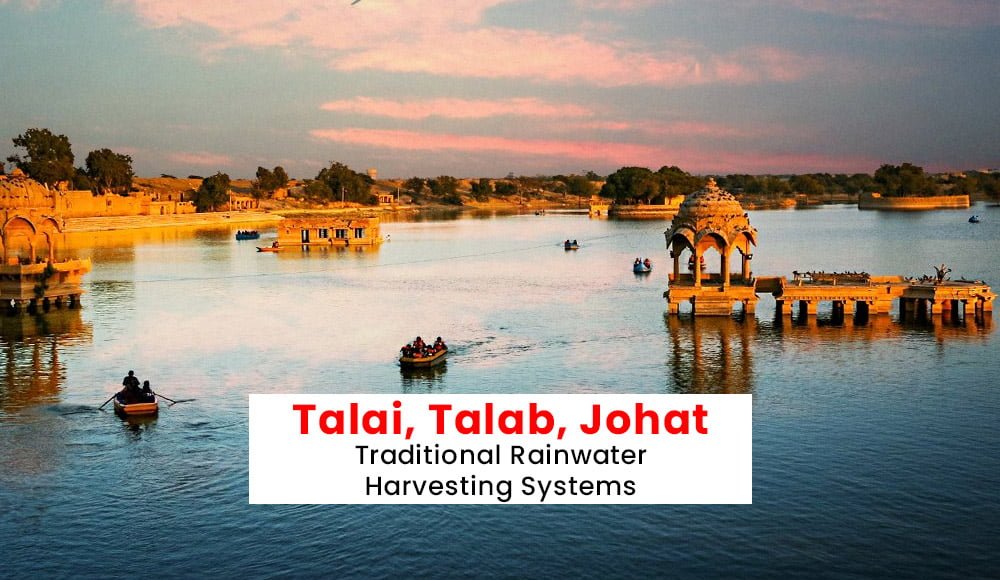Talai, Talab and Johat! We have all heard these names since our childhood as they comprise the traditional water harvesting systems of India.
Since ancient times, our ancestors have invented various thoughtful and genius methods, to harvest water, for present and future use right since Indus Valley Civilization.
Even today, town planners keep a special place for water reservoirs with proper catchment channels while chalking out the grid plan of the town. There are many benefits of water harvesting like reduction in soil erosion, increase in ground water levels and tree cover, control over frequent floods and droughts, and having a year round supply of water. Different methods of water harvesting are used in different parts of India according to geographical terrains.
Let’s have a look at 6 traditional methods of water harvesting that are still in use.

- Talab/Bandhis/Pond: Almost every town and village has a pond or lake for water supply. Either it is natural like or man-made. The examples of natural lakes and man-made lakes are:
- Pichola Lake in Udaipur (natural)
- Pushkar Lake in Ajmer (natural)
- Siliserh Lake in Alwar (natural)
- Foy Sagar Lake in Ajmer (man-made)
- Gadisar Lake in Jaisalmer (man-made)
- Balsamand Lake in Jodhpur (man-made)
They store huge quantities of water for drinking, household, religious and tourism purposes. Rain water is collected via narrow streams coming from various directions. Names are given according to size:
a) Talai – water body within 5 bighas.
b) Talab/Bandhi – a lake of medium size.
c) Sagar/Samand – A bigger sized lake.
- Johads: Mainly found in the arid state of Rajasthan, these are small earthen(mud) check dams built to harvest and store rainwater for various purposes including recharging ground water. You will find them in areas having natural elevation on three sides where a reservoir pit has been dug out and an earthen embankment is constructed on the 4th side by the excavated mud. Sometimes a number of Johads are inter linked to balance out the water pressure on its walls.
- Baoris/Stepwells: This traditional Water Harvesting method is unique to North-western and Western India. The scarce rainfall received by this semi-arid region is collected in man-made tanks by connecting them with canals built in hilly catchment areas. And to minimize water evaporation, a flight of steps are built around it to narrow down and deepen the well/tank. Such enormous structures were mainly built in cities for drinking purposes. Delhi and Bundi district have beautifully designed baoris. Examples are:-
- Chand Baori in Abhaneri village near Jaipur having 3500 deep steps and 13 storeys.
- Rani ki Baori in Bundi district.
- Ahar Pynes: This ancient flood water harvesting system is indigenous to southern Bihar. Ahar is a water reservoir having embankments on 3 sides and pynes are narrow water streams dug out to divert excess water from rivers to Ahar. This traditional Water harvesting system controls floods and can irrigate up to 400 acres.
- Kul/Kuhls: Kuls are diversion channels that carry water from streams of melted glaciers to the villages. It is a traditional Water harvesting and irrigation system prevalent in Himachal Pradesh especially in rain shadow region of Spiti Valley. Kuls/canals drain their water in a circular pond in the village from where water is diverted towards fields for irrigation purposes. One Kul system can irrigate around 20 hectare of land. There are more than 300 Kuhls in Himachal Pradesh for community welfare.
- Eri: An old water storage system using tanks is widespread in Tamil Nadu. These tanks are fed naturally by rain water or by diversion channels carved out from rivers. Several eris are interconnected to provide water to the remotest of villages for their daily needs. Even today 1/3 of the irrigation in Tamil Nadu is still done through these huge water bodies. Majority of the rich paddy cultivation is credited to this traditional and highly useful water harvesting and irrigation system. This ancient system is very reliable in controlling floods, prevention of soil erosion, groundwater replenishment and storing of flowing rain water.


